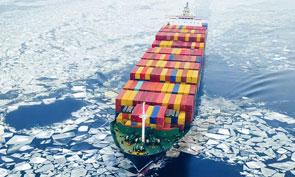
In September 2018, Maersk Line, the world’s biggest container shipping company, announced that their new 42,000 ton ice class, Venta Maersk, was the first container ship to complete the journey carrying Russian fish and South Korean electronics from Vladivostok to St Petersburg. This shaves around 3,000 nautical miles off the traditional route via the Suez Canal. It’s an incredible development and has the potential to significantly reduce costs and CO₂ emissions as the route becomes more viable.
While ice is diminishing on some routes, it is becoming an increasing danger in others. Over 1,000 icebergs drifted into North Atlantic shipping lanes in 2017, making it the fourth consecutive season where the danger has been classified as extreme. Heightened risk of icebergs have also been noted on southern shipping routes around the Antarctic as well as in Alaska, the Gulf of St Lawrence and The Baltic. There are even fears that this unprecedented proliferation of icebergs may lead to the re-routing of certain shipping lanes.
There is little doubt that climate change will continue for some time ahead. Arctic ice has been thinning and retreating over the past 40 years, bringing new opportunities for shipping. Research shows the mean center of shipping activity has moved 300 km closer to the North Pole over a seven-year span. A growing number of vessels are sailing in Arctic waters. Cargo volumes increased by nearly 40%, to a record 9.7 million tonnes in 2017, and they are forecast to rise to 40-million tons by 2022, and twice that by 2030. At the beginning of 2017 the International Code of Safety for Ships Operating in Polar Waters introduced mandatory requirements for all shipping in polar regions. It currently relates to ice navigation, manning and ship design but it continues to be refined.
Of course, the impact of global warming will have an impact on what is happening inside your container too. Fluctuations in temperature, combined with ventilation issues are a significant cause of condensation which can lead to destroyed cargo. We’ve recently written about the cause of moisture damage here.
To succeed in this period of unprecedented change, you will need to exploit new opportunities as they open up and mitigate new risks as they are identified. To do that, you will need an innovative and reliable partner to ensure the safety of your cargo. New routes will mean new codes and you will require expert guidance to help navigate them and understand their implications for cargo securing. Cordstrap have developed the world’s leading container protection solutions, supported with onsite diagnostics and cargo protection advice. We are the only cargo protection specialist with a global network that can offer implementation support and training wherever you need it in the world. Our knowledge of current codes is second to none and we enjoy full accreditation from Germanischer Lloyd, the International Maritime Organisation and Mariterm AB. Consequently, no one is better placed to offer expert advice on every regulation and law you will encounter and ensure that your cargos are fully compliant worldwide.
To find out more about the full range of cargo protection solutions Cordstrap can deliver and how they can protect your business in a changing world, click here.
For expert advice on cargo securing solutions contact us now
Contact nowCordstrap have specialists in over 50 global locations
Providing physical insurance to the world’s major industries
Delivering cargo protection solutions